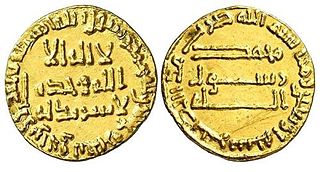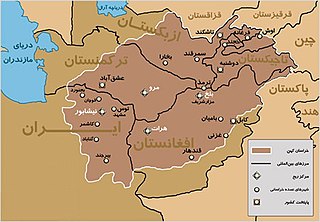Related Research Articles

The history of Islam concerns the political, social, economic, military, and cultural developments of the Islamic civilization. Most historians believe that Islam originated with Muhammad's mission in Mecca and Medina at the start of the 7th century CE, although Muslims regard this time as a return to the original faith passed down by the Abrahamic prophets, such as Adam, Noah, Abraham, Moses, David, Solomon, and Jesus, with the submission (Islām) to the will of God.

The Umayyad Caliphate(Pronounced variously, ; Arabic: ٱلْخِلَافَة ٱلْأُمَوِيَّة, romanized: al-Khilāfah al-ʾUmawīyah) or Umayyad Empire was the second caliphate established after the death of the Islamic prophet Muhammad. The caliphate was ruled by the Umayyad dynasty, also known as the Umayyads. Uthman ibn Affan, the third of the Rashidun caliphs, was also a member of the clan. The family established dynastic, hereditary rule with Muawiya ibn Abi Sufyan, long-time governor of Greater Syria, who became caliph after the end of the First Fitna in 661. After Mu'awiya's death in 680, conflicts over the succession resulted in the Second Fitna, and power eventually fell to Marwan I, from another branch of the clan. Syria remained the Umayyads' main power base thereafter, with Damascus as their capital.

The Abbasid Caliphate or Abbasid Empire was the third caliphate to succeed the Islamic prophet Muhammad. It was founded by a dynasty descended from Muhammad's uncle, Abbas ibn Abd al-Muttalib, from whom the dynasty takes its name. They ruled as caliphs for most of the caliphate from their capital in Baghdad in modern-day Iraq, after having overthrown the Umayyad Caliphate in the Abbasid Revolution of 750 CE (132 AH). The Abbasid Revolution had its origins and first successes in the easterly region of Khorasan, far from the bases of Umayyad power in Syria and Iraq. The Abbasid Caliphate first centered its government in Kufa, modern-day Iraq, but in 762 the caliph Al-Mansur founded the city of Baghdad, near the ancient Babylonian capital city of Babylon and Persian city of Ctesiphon. Baghdad became the center of science, culture, and invention in what became known as the Golden Age of Islam. This, in addition to housing several key academic institutions, including the House of Wisdom, as well as a multiethnic and multi-religious environment, garnered it an international reputation as the "Centre of Learning".

Abū Jaʿfar ʿAbd Allāh ibn Muḥammad al-Manṣūr usually known simply as by his laqab al-Manṣūr (المنصور) was the second Abbasid caliph, reigning from 136 AH to 158 AH succeeding his brother al-Saffah. He is known for founding the 'Round City' of Madinat al-Salam, which was to become the core of imperial Baghdad.

Abu Muslim Abd al-Rahman ibn Muslim al-Khurasani or Behzādān Pour Vandād Hormozd was a Persian general who led the Abbasid Revolution that toppled the Umayyad dynasty, leading to the establishment of the Abbasid Caliphate.

Kufa, also spelled Kufah, is a city in Iraq, about 170 kilometres (110 mi) south of Baghdad, and 10 kilometres (6.2 mi) northeast of Najaf. It is located on the banks of the Euphrates River. The estimated population in 2003 was 110,000. Currently, Kufa and Najaf are joined into a single urban area that is mostly commonly known to the outside world as 'Najaf'.

The Tahirid dynasty was an Arabized Sunni Muslim dynasty of Persian dehqan origin that ruled as governors of Khorasan from 821 to 873 as well as serving as military and security commanders in Abbasid Baghdad until 891. The dynasty was founded by Tahir ibn Husayn, a leading general in the service of the Abbasid caliph al-Ma'mun. For his support of al-Ma'mun in the Fourth Fitna, he was granted the governance of Khorasan.

A caliphate or khilāfah is an institution or public office under the leadership of an Islamic steward with the title of caliph, a person considered a political-religious successor to the Islamic prophet Muhammad and a leader of the entire Muslim world (ummah). Historically, the caliphates were polities based on Islam which developed into multi-ethnic trans-national empires. During the medieval period, three major caliphates succeeded each other: the Rashidun Caliphate (632–661), the Umayyad Caliphate (661–750), and the Abbasid Caliphate (750–1258). In the fourth major caliphate, the Ottoman Caliphate, the rulers of the Ottoman Empire claimed caliphal authority from 1517 until the caliphate was abolished as part of the 1924 secularisation of Turkey. Throughout the history of Islam, a few other Muslim states, almost all hereditary monarchies such as the Mamluk Sultanate (Cairo) and Ayyubid Caliphate, have claimed to be caliphates.

Bābak Khorramdin was one of the main Iranian revolutionary leaders of the Iranian Khorram-Dinān, which was a local freedom movement fighting the Abbasid Caliphate. Khorramdin appears to be a compound analogous to dorustdin "orthodoxy" and Behdin "Good Religion" (Zoroastrianism), and are considered an offshoot of neo-Mazdakism. Babak's Iranianizing rebellion, from its base in Azerbaijan in northwestern Iran, called for a return of the political glories of the Iranian past. The Khorramdin rebellion of Babak spread to the Western and Central parts of Iran and lasted more than twenty years before it was defeated when Babak was betrayed. Babak's uprising showed the continuing strength in Azerbaijan of ancestral Iranian local feelings.

Greater Khorāsān, or Khorāsān is a historical eastern region in the Iranian Plateau between Western and Central Asia.
The Islamization of Iran was the spread of Islam in formerly Sassanid Iran as a result of the Muslim conquest of the empire in 633–654. It was a long process by which Islam, though initially rejected, eventually spread among the population on the Iranian Plateau. Iranian peoples have maintained certain pre-Islamic traditions, including their language and culture, and adapted them with Islamic codes. These two customs and traditions merged as the "Iranian Islamic" identity.

Chaghaniyan, known as al-Saghaniyan in Arabic sources, was a medieval region and principality located on the right bank of the Oxus River, to the south of Samarkand.

The Rashidun Caliphate was the first caliphate to succeed the Islamic prophet Muhammad. It was ruled by the first four successive caliphs of Muhammad after his death in 632 CE. During its existence, the empire was the most powerful economic, cultural, and military force in the Middle East.
Al-Mada'in was an ancient metropolis situated on the Tigris in what is now Iraq. It was located between the ancient royal centers of Ctesiphon and Seleucia, and was founded by the Sasanian Empire. The city's name was used by Arabs as a synonym for the Sasanian capital of Ctesiphon, in a tradition that continued after the Arab conquest of Iran.

The Bavand dynasty, or simply the Bavandids, was an Iranian dynasty that ruled in parts of Tabaristan in what is now northern Iran from 651 until 1349, alternating between outright independence and submission as vassals to more powerful regional rulers. They ruled for 698 years, which is the second longest dynasty of Iran after the Baduspanids.

The Abbasid Revolution, also called the Movement of the Men of the Black Raiment, was the overthrow of the Umayyad Caliphate, the second of the four major Caliphates in Islamic history, by the third, the Abbasid Caliphate. Coming to power three decades after the death of the Islamic prophet Muhammad and immediately after the Rashidun Caliphate, the Umayyads were an Arab empire ruling over a population which was overwhelmingly non-Arab. Non-Arabs were treated as second-class citizens regardless of whether or not they converted to Islam, and this discontent cutting across faiths and ethnicities ultimately led to the Umayyads' overthrow. The Abbasid family claimed descent from al-Abbas, an uncle of Muhammad.
Al-Hasan ibn Qahtaba ibn Shabib al-Ta'i was a senior military leader in the early Abbasid Caliphate.
The Muslim conquest of Khorasan, or Arab conquest of Khorasan, was the last phase of the heavy war between the Arab Rashidun caliphate against the Sassanid Empire.
References
- ↑ "ʿARAB ii. Arab conquest of Iran – Encyclopaedia Iranica" . Retrieved 25 April 2021.
- ↑ "تکمله ای بر "دوقرن سکوتِ" زرین کوب: سکوت ایران سیاسی بود یا فرهنگی؟ - خبرگزاری مهر" (in Persian). Retrieved 25 April 2021.
- ↑ Madelung, Wilferd (1997). The Succession to Muhammad. Cambridge University Press.
- ↑ Elizabeth Goldman (1995), p. 63, gives 8 June 632 CE, the dominant Islamic tradition. Many earlier (primarily non-Islamic) traditions refer to him as still alive at the time of the invasion of Palestine. See Stephen J. Shoemaker,The Death of a Prophet: The End of Muhammad's Life and the Beginnings of Islam, page 248, University of Pennsylvania Press, 2011.
- ↑ Mirsalim, Mostafa. Encyclopedia of the World of Islam (in Persian). EncyclopaediaIslamica Foundation.
- ↑ Robinson, Chase F. (2010). The New Cambridge History of Islam. Cambridge University Press.
- ↑ Daniel, Elton L. (1985). Encyclopædia Iranica, CONVERSION ii. Of Iranians to Islam. Encyclopædia Iranica Foundation, Brill.
- ↑ Frye, Richard N. (2000). The Golden Age of Persia. Phoenix Press. pp. 69–71. ISBN 9781842120118.
- ↑ Daryaee, Touraj (2008). Sasanian Iran (224-651 CE): Portrait of a Late Antique Empire. Mazda Publishers. p. 101.
- ↑ Frye, Richard N. (2000). The Golden Age of Persia. Phoenix Press. p. 69. ISBN 9781842120118.
- ↑ Lapidus, Ira M. (1988). A History of Islamic Societies. Cambridge University Press. pp. 34–38.
- ↑ Hoyland 2015, p. 98.
- ↑ Momtahen, Hosseinali (2004). Nehzate Sho'Oubieh (in Persian). Tehran: Elmi Farhangi. p. 146.
- ↑ Zarrinkoob, Abdolhossein (1964). History of Iran, after Islam (in Persian). Amirkabir. p. 352.
- ↑ Donaldson, Dwight M. (1933). The Shi'ite Religion: A History of Islam in Persia and Irak. BURLEIGH PRESS. pp. 66–78.
- ↑ Jafri, Syed Husain Mohammad (2002). The Origins and Early Development of Shi'a Islam; Chapter 6. Oxford University Press. ISBN 978-0195793871.
- ↑ Shaykh Radi Aal-Yasin; Translated by Jasim al-Rasheed. Sulh al-Hasan (The Peace Treaty of al-Hasan (a)). Qum: Ansariyan Publications. Retrieved 30 December 2013.
- ↑ "Hadith - Muawiyah initiated peace with Hasan(RA)- Sahih al-Bukhari - Sunnah.com - Sayings and Teachings of Prophet Muhammad (صلى الله عليه و سلم)". sunnah.com. Retrieved 2021-01-07.
- ↑ Zarrinkoob, Abdolhossein (1964). History of Iran, after Islam (in Persian). Amirkabir. p. 353.
- ↑ Momtahen, Hosseinali (2004). Nehzate Sho'Oubieh (in Persian). Tehran: Elmi Farhangi. p. 145.
- ↑ Zarrinkoob, Abdolhossein; Frye, Richard N. (1975). The Cambridge History of Iran, THE ARAB CONQUEST OF IRAN AND ITS AFTERMATH. Vol. 4. London: Cambridge University Press. p. 46.
- ↑ al-Isfahani, Abu al-Faraj (1989). Kitab al-Aghani (in Persian). Vol. 4. Elmi Farhangi. p. 423.
- ↑ Al-Biruni, Abu Rayhan; Sachau, Eduard (1879). The Remaining Signs of Past Centuries . pp. 35–36, 48.
- ↑ Browne, Edward G. (2001). Islamic Medicine. Al-Risala. p. 16. ISBN 8187570199.
- ↑ Zarrinkoob, Abdolhossein; Frye, Richard N. (1975). The Cambridge History of Iran, THE ARAB CONQUEST OF IRAN AND ITS AFTERMATH. Vol. 4. London: Cambridge University Press. p. 42.
- ↑ Sadighi, Gholam Hossein (1993). Iranian religious movements (in Persian). Tehran: Pazhang. pp. 40–41.
- 1 2 Sadighi, Gholam Hossein (1993). Iranian religious movements (in Persian). Tehran: Pazhang. p. 41.
- ↑ Sadighi, Gholam Hossein (1993). Iranian religious movements (in Persian). Tehran: Pazhang. pp. 41–42.